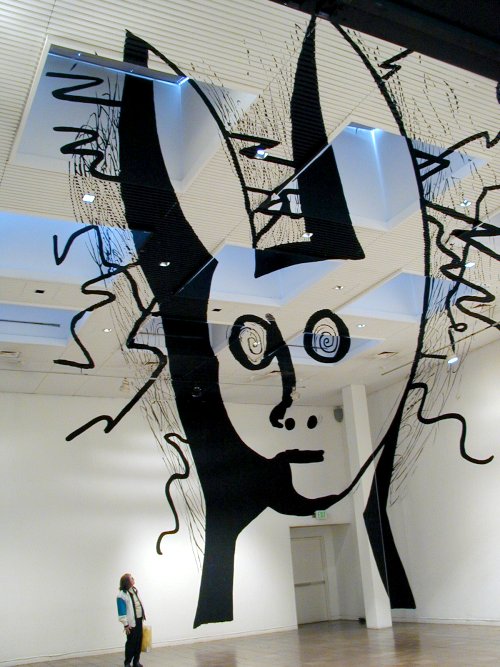Tricking the Eye
Today, we trick the eye. The University of Houston's College of Engineering presents this series about the machines that make our civilization run, and the people whose ingenuity created them.
I recently visited Fort Worth's Modern Art Museum, where I discovered a perfectly remarkable installation. You walk into a large white solarium and see black paint splashed on the walls and ceiling. It looks like nothing at all until you stand in just the right position. Then it all morphs into a huge picture by artist Jonathan Borofsky entitled Self-Portrait with Big Ears.
This visual tour de force catches the viewer up into a contagious sort of delight. It offers a lesson on perspective and the workings of the human eye. As you leave, you realize that the artist must've projected the image from that single position, then painted in the walls, window wells, and ceiling, and finally left you to reverse that projection and take the image into your own eye.
Now I read Frances Tarpak's descriptions of optical devices based on holdings at the Getty Museum. She quotes Descartes, who noted that you could cut the back off a human or animal eyeball. Its lens would then cast an inverted image of the view before it onto the wall behind it -- just like a camera obscura.
Descartes caught the mood of the seventeenth century's new obsession with seeing. The camera obscura was nothing more than a large camera without film -- a box with a lens in one side, casting an upside-down image of the outside on the far wall. You and I flinch when we hear that. The idea of an eye replicating a machine seems very odd. But the same determinist Descartes argued that animals are no more than robotic machines.
Machines thus joined hands with art, and the results were strange. Painters invented trompe-l'oeil -- a painting meant to trick the eye: A viewer sees a picture of a window and thinks he's looking out a real window. A long narrow painting of Saint Margaret and the Dragon, tapered from left to right, looks like meaningless streaks until you view it from the far right. Suddenly, like that picture in Fort Worth, it becomes a realistic image. And, like the image in Fort Worth, this one could only have been created with aid of a mechanical eye.
The seventeenth century was the age of mathematical instruments. Modern science was being erected about microscopes, telescopes, elementary calculating machines, and much more. But the chasm between seeing in the mind and seeing in the world caught people in a web of philosophical complexity.
The early eighteenth century found a Swiss doctor, Jakob Scheuchzer, struggling with this issue. He wrote:
[The eye] is like a small world in another small world: a dark chamber of infinite art, and without which all the beauties of the world would be as nothing. By the use of light [it] distinguishes the living from the dead.
The glorious weavings of shadow and light by computer and TV lull us into complacency. We accept the image and forget the mystery that still divides the lens from the mind. Perhaps that is what I felt as I left that room in Fort Worth -- the shiver of an old mystery walking across my mind.
I'm John Lienhard, at the University of Houston, where we're interested in the way inventive minds work.
(Theme music)
Stafford, B. M., Terpak, F., Devices of Wonder. Los Angeles: The Getty Research Institute, 2001. (My thanks to University of Houston Art and Architecture Librarian Margaret Culbertson for bringing this source to my attention.)

Self-Portrait with Big Ears by Jonathan Borofsky.
(Modern Art Museum, Fort Worth, TX. Photo by John Lienhard)